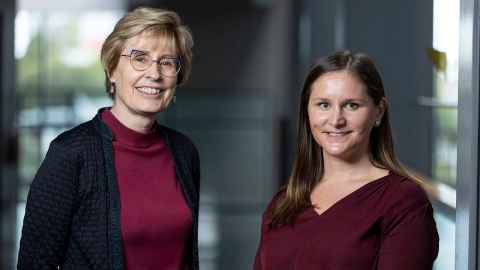Hope for better cerebral palsy outcomes
22 July 2022
Work to bring forward cerebral palsy diagnoses in babies has had a boost with $200k funding from CP Australia.

A pair of researchers at the University of Auckland have led a successful bid to trial regional hubs for diagnosing cerebral palsy.
One in 500 babies is born with cerebral palsy yet, in Aotearoa New Zealand, children are not diagnosed until they are an average of 19 months old, something the researchers want to change.
Doctors have traditionally taken a “wait-and-see” approach to cerebral palsy, but that means children may miss out on treatment during a period of peak neuroplasticity, say Dr Sian Williams of the Liggins Institute and Professor Sue Stott of the Faculty of Medical and Health Sciences.
“Doctors may have suspicions, but not want to give bad news. That's been a huge barrier and gives the impression that there’s nothing to be done early,” Professor Stott says.
However, families say they want to know as soon as possible and shouldn’t have to fight for a diagnosis, according to Stott and Williams’ research.
Further, earlier diagnosis and treatment could lead to reduced impairments and improved ability and independence for people with cerebral palsy.
Around 60 percent of the 57 families who participated in a 2021 study expressed concerns about their child before six months of age, but only 21 percent were provided with a diagnosis. Eighteen percent of the families experienced a delay in diagnosis of more than a year (J Clin Med 2021;10(7):1398).
“New Zealand families seek provision of early, honest and ongoing communication with their healthcare professionals about their child,” Williams says. “In addition, families experience challenges relating to a lack of post-diagnosis support, such as counselling and guidance that might help them navigate the health system.”
There are three reliable diagnostic tools that, along with the child’s history, can accurately detect, or identify high risk of cerebral palsy in babies as young as three months old.
The tools are MRI, general movements assessment (GMs) and the Hammersmith Infant Neurological Examination (HINE).
Yet, while doctors have a high awareness of these tools, only MRIs are routinely employed, perhaps because of a lack of training, time, or clear guidance on when to use the tools, Stott and Williams say.
In a new paper, Stott and Williams show that neuroimaging is commonly used with very preterm and term babies, but not with moderate-to-late preterm babies. In addition, neuroimaging didn’t always detect cerebral palsy in babies that were later found to have the condition, suggesting other tools such as GMs and HINE should be used more routinely (J Clin Med 2022;11(7):1866).
The HINE takes around 10 to 15 minutes to assess the child’s movements, posture and muscle tone, while the GMs involves a three-minute video taken of the baby while awake and calm, which is later reviewed to determine the quality of their movements.
Best practice guidelines were recently published.
Williams and Stott are now working with clinicians based at Starship Children’s Health and around the country to translate research into everyday practice.
They were part of a successful funding bid to the CP Alliance Research Foundation (Australia) for $200k to support a pilot of an ‘early diagnosis hub’ for cerebral palsy in the Wellington region and a further $200k to support research in this area.
If the trial is successful, the goal is for these hubs to be established around New Zealand.
This would mean doctors could refer families into these specialised services, which in turn could support local services with advice on how best to provide early care for babies with cerebral palsy.
“Ideally, every baby would be assessed in their local centre, but we know that is not realistic to start with, and training is needed to use the diagnostic tools,” Stott says.
While many early interventions are showing promise from research overseas, New Zealand hasn’t had enough very young babies diagnosed to enter large clinical trials. The first step is to improve diagnosis, so that New Zealand children can also participate in the research.
Nonetheless, Williams and Stott have recently published a paper showing the changes in skeletal muscle in people with cerebral palsy and the effects of common treatments targeted at improving muscle function (BMC Musculoskelet Disord 2022;23:233).
“It is thought that, if targeted interventions can be introduced earlier, we might be able to change the way a child with cerebral palsy muscles develop,” Williams says.
There have already been great gains in prevention of cerebral palsy and, with those, a lessening of disability.
This pair, and the clinicians and researchers they collaborate with, hope to further improve the abilities of children with cerebral palsy and improve education and support for their families.